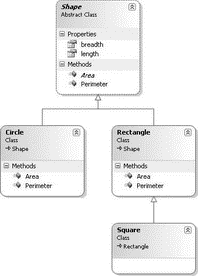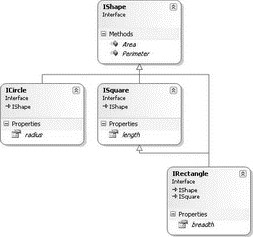Книга: C# 2008 Programmer
Interface Inheritance
Interface Inheritance
When an interface inherits from a base interface, it inherits all the base interface's functions signatures (but no implementation).
Let's explore the concept of interface inheritance by using the hierarchy of various classes defined earlier in the chapter, starting from the root class Shape, with the Circle and Rectangle classes inheriting from it (the Square class in turn inherits from the Rectangle class), as Figure 6-8 shows.

Figure 6-8
One problem with this class hierarchy is that for the Circle class, using the inherited length property to represent the diameter is a bit awkward. Likewise, for the Square class the width property should not be visible because the length and width of a square are the same. Hence, these classes could be better rearranged.
As you recall from Chapter 5, you can use an interface to define the signature of a class's members. Likewise, you can use interfaces to define the hierarchy of a set of classes. If you do so, developers who implement this set of classes will have to follow the rules as defined in the interfaces.
You can use interfaces to redefine the existing classes, as shown in Figure 6-9.

Figure 6-9
Here, the IShape interface contains two methods — Area() and Perimeter():
public interface IShape {
//---methods---
double Perimeter();
double Area();
}
Remember, an interface simply defines the members in a class; it does not contain any implementation. Also, there is no modifier (like virtual or abstract) prefixing the function members here, so you need not worry about the implementation of the Perimeter() and Area() methods — they could be implemented by other derived classes.
The ICircle interface inherits from the IShape interface and defines an additional radius property:
public interface ICircle : IShape {
//---property---
double radius { get; set; }
}
The ISquare interface inherits from the IShape interface and defines an additional length property:
public interface ISquare : IShape {
//---property---
double length { get; set; }
}
The IRectangle interface inherits from both the IShape and ISquare interfaces. In addition, it also defines a width property:
public interface IRectangle : IShape, ISquare {
//---property---
double width { get; set; }
}
So what does the implementation of these interfaces look like? First, implement the ISquare interface, like this:
public class Square : ISquare {
//---property---
public double length { get; set; }
//---methods---
public double Perimeter() {
return 4 * (this.length);
}
public double Area() {
return (Math.Pow(this.length, 2));
}
}
Here, you provide the implementation for the length property as well as the two methods — Perimeter() and Area().
You not need to implement the IShape class because you can't provide any meaningful implementation of the Area() and Perimeter() methods here.
Because the IRectangle interface inherits from both the ISquare and IShape interfaces and the ISquare interface has already been implemented (by the Square class), you can simply inherit from the Square class and implement the IRectangle interface, like this:
public class Rectangle : Square, IRectangle {
//---property---
public double width { get; set; }
}
If you implement the IRectangle interface directly (without inheriting from the Square class, you need to provide the implementation of the length property as well as the methods Perimeter() and Area().
You need only provide the implementation for the width property here. The implementation for the Area() and Perimeter() methods is inherited from the Square class.
The last implementation is the ICircle interface, for which you will implement the radius property as well as the Perimeter() and Area() methods:
public class Circle : ICircle {
public double radius { get; set; }
public double Perimeter() {
return (2 * Math.PI * (this.radius));
}
//---provide the implementation for the virtual method---
public double Area() {
return (Math.PI * Math.Pow(this.radius, 2));
}
}
Figure 6-10 shows the classes that you have implemented for these three interfaces.

Figure 6-10
- Chapter 6 Inheritance
- Understanding Inheritance in C#
- Implementation Inheritance
- Explicit Interface Members Implementation
- 5.5.5.2 Priority inheritance mutexes
- Chapter 15. Graphical User Interfaces for Iptables
- Displaying Interface Statistics
- QueryInterface и IUnknown
- 5.1.2. The Directory Server Interface
- Command-Line Network Interface Configuration
- Laying the Foundation: The localhost Interface
- Checking for the Availability of the Loopback Interface




